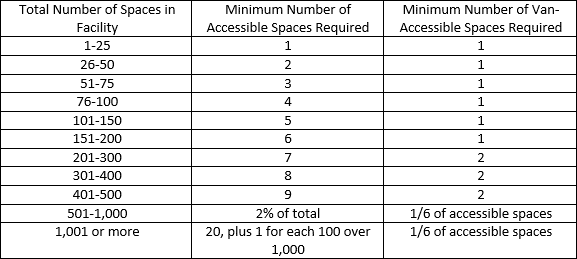Number of Spaces:
- Hospital outpatient facilities- 10% of total spaces must be accessible
- Rehabilitation facilities and outpatient physical therapy facilities- 20% of spaces must be accessible

Dimensions:
- Spaces must have a vertical clearance of at least 98 in. to allow for the height of typical wheelchair lift-equipped vehicle
- Aisles and spaces must be smooth, stable, and level
- Access Aisles must be marked to discourage parking in them
- Note: van-accessible spaces may be 8 ft. wide IF the adjacent access aisle is also 8 ft. wide

Signs:
- Accessible spaces must be identified by the International Symbol of Accessibility
- Van-accessible spaces must include the additional phrase “van-accessible”
- Must be mounted at least 5 feet above the ground
Location:
- Accessible spaces must connect to the shortest accessible route to the accessible entrance of the facility and they should be kept free from snow, ice, or anything else that might block access.
- If a parking facility serves multiple buildings or accessible entrances, accessible parking spaces should be dispersed to enable people to park near as many accessible entrances as possible
- If separate parking facilities serve the same buildings or accessible entrances, accessible parking spaces may be grouped together, as long as the number of accessible spaces is determined according to the total number of spaces in all of the separate parking facilities
Exceptions:
- Parking spaces used exclusively for buses, trucks, other delivery vehicles, law enforcement vehicles, or vehicular impound do not need to comply with ADA regulations
- Safe Harbor– Facilities that meet the 1991 ADA Standards but do not meet the 2010 ADA Standards do not have to modify their parking until the facility undergoes a planned alteration. Any Alterations made after March 15, 2012 must comply with the 2010 standards.
These regulations cover Title II and Title III of the ADA:
- Title II: All services, programs, and activities provided by state and local governments, such as police and fire stations, courts, parks, etc.
- Title III: Public accommodations and commercial facilities such as restaurants, movie theaters, day care facilities, recreation facilities, doctors’ offices, etc.
Be Advised: Failure to comply with the federally mandated parking requirements of the ADA may result in legal action from the DLC